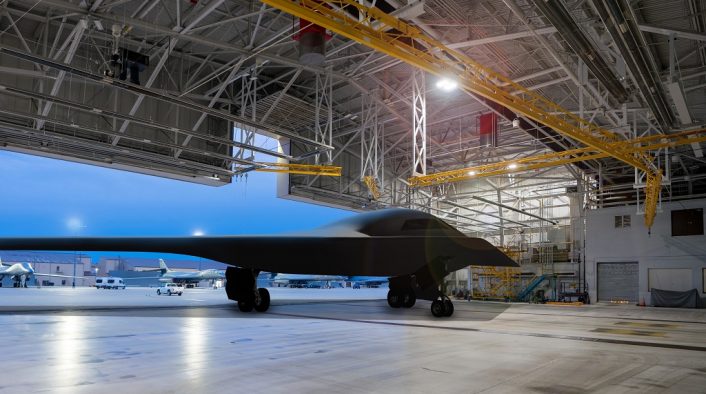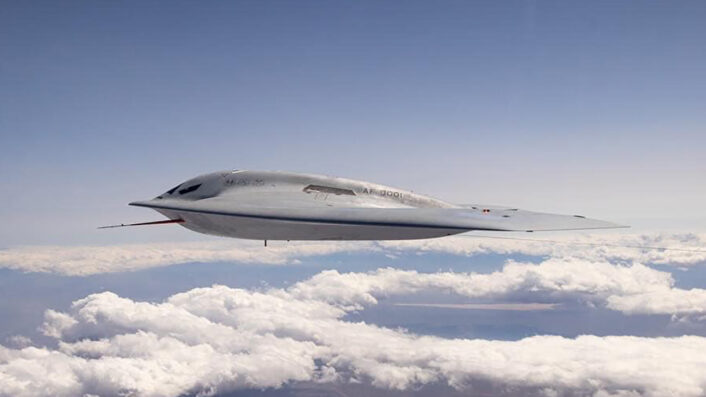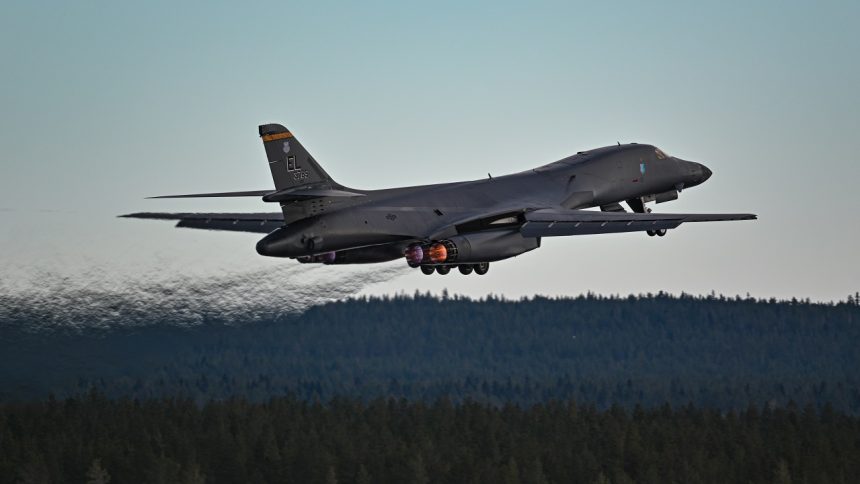The B-1B bombers’ relocation to Grand Forks AFB for ten months would allow Ellsworth AFB to renovate its runway as works continue in preparation for the B-21’s arrival.
Grand Forks Air Force Base, North Dakota, might host again the B-1B Lancer bomber 30 years after it left the base and the former 319th Bomb Wing first transitioned to the air refueling mission and later to the reconnaissance mission. In fact, the U.S. Air Force is verifying the feasibility of the bombers’ relocation from Ellsworth Air Force Base, South Dakota, to Grand Forks next year.
The temporary move would last ten months, starting in February 2025, and will allow Ellsworth to renovate its runway as works continue in preparation for the B-21 Raider’s arrival. Sen. John Hoeven told the Grand Forks Herald last week that 17 B-1B Lancer bombers would likely be reassigned to Grand Forks.
Spokespersons for the Air Force Global Strike Command and Grand Forks AFB confirmed to Air and Space Forces Magazine and the Grand Forks Herald that decision is not definitive. In fact, the final decision is dependent on the results of the ongoing environmental review that will evaluate the impact of the relocation.
Should the transfer be confirmed, 800 Airmen will move along the bombers for maintenance and operations’ support. In addition to housing and transportation for the personnel, Grand Forks might also need temporary hangars to house the B-1s.
Ellsworth AFB
Ellsworth AFB is home of the 28th Bomb Wing and its 28th Operations Group, under which fall the 34th Bomb Squadron and the 37th Bomb Squadron, equipped with the B-1B Lancer bomber. Ellsworth is one of the two bases which are assigned the BONE (as the B-1 is nicknamed in the pilot community), with the other being Dyess AFB, Texas.
Ellsworth, 10 miles northeast of Rapid City, has a long story with the bomber mission starting in WW2. The base was assigned the B-52 Stratofortress in 1957 and replaced it with the B-1B 30 years later, in 1987, becoming the second to be equipped with the new bomber.

The base has now been selected to be the first to receive the new B-21 Raider stealth bomber. Shortly after being selected as initial operating base and training unit, Ellsworth started the construction of a new 95,000-square-foot Low Observable Restoration Facility.
Additional facilities, including a Weapons Generation Facility, a Radio Frequency Facility, mission operation planning facility, field training detachment facility, formal training unit, two maintenance hangars and a flight simulator facility are under construction. The base will construct or renovate more than 20 major facilities before the B-21’s arrival, with works completed between 2025 and 2026.
Grand Forks AFB
Grand Forks AFB was established in the 1950s as an Air Defense Command’s base, but shortly thereafter became part of the Strategic Air Command and also received the B-52. The 319th Bomb Wing replaced in 1987 the B-52H with the B-1B, until in 1994 the bombers were relocated and the wing became an Air Refueling Wing first and later a Reconnaissance Wing.
The base is located 380 miles northeast of Ellsworth. Although it already hosted nuclear and conventionally-armed bomber aircraft, the B-1B’s return to Grand Forks is not straightforward, as many things have changed since 1994.
Other than the duration of the relocation from February to November 2025, details are actually scarce. In fact, as base spokesperson mentioned, it’s “still a bit early for fully releasable details” as the Air Force is still performing all the required evaluations.
While the Air Force already started divesting the B-1 in 2021, decreasing the active fleet size from 62 to 45 aircraft, the service still needs to support the bomber’s operations for the time being. “The B-1s will continue to fill their operational requirements to the President and the Secretary of Defense while at Grand Forks,” an AFGSC spokesman noted.
B-21 program status
Shortly after the beginning of flight testing, Northrop Grumman has been awarded the contract for the Low-Rate Initial Production of the new B-21 Raider stealth bomber. The Pentagon did not release the contract’s details, however, when at the bomber’s rollout in 2022, the Air Force stated it expected average unit procurement cost of $692 million.
The number of aircraft covered by the first contract was not disclosed, although some reports after the first flight said it could cover up to 21 aircraft. At the time of the first flight, Northrop Grumman said six airframes were in various stages of production, including the one already flying, which was named “Cerberus”.
The B-21 Raider is carrying out test flights out of Edwards Air Force Base, in California, where the aircraft landed at the end of its first flight from Air Force Plant 42 in Palmdale on Nov.10, 2023. Although the U.S. Air Force has been tight-lipped about the status of the secretive aircraft since then, with no further details or photos of the bomber’s first flight and arrival at Edwards AFB released, it acknowledged that the flight test campaign is proceeding.

A spokesperson confirmed, in fact, that the B-21 flew on Jan. 17, 2024, adding that the Air Force would not provide further details about the test program nor the number of flights the aircraft has flown. A flight test was rumored to have taken place on Mar. 28, while another one possibly took place on Apr. 1. The stealth bomber took to the skies again on Apr. 4, 2024, when it was caught in a video while flying at high altitude, escorted by a chase aircraft.
In May, both the Air Force and Northrop Grumman released photos the first photos of the B-21 in flight. In the same period, Andrew Hunter, the Air Force’s Service Acquisition Executive, provided a rare update on the B-21’s status mentioning the “flight test program is proceeding well.”
Hunter noted that the program is on track, with significant milestones expected this year, and expressed optimism about the results. U.S. Air Force Chief of Staff Gen. David W. Allvin mentioned that the Air Force might limit the acquisition to the planned 100 B-21 Raiders, as newer technologies could emerge by the time these bombers are built and delivered.









